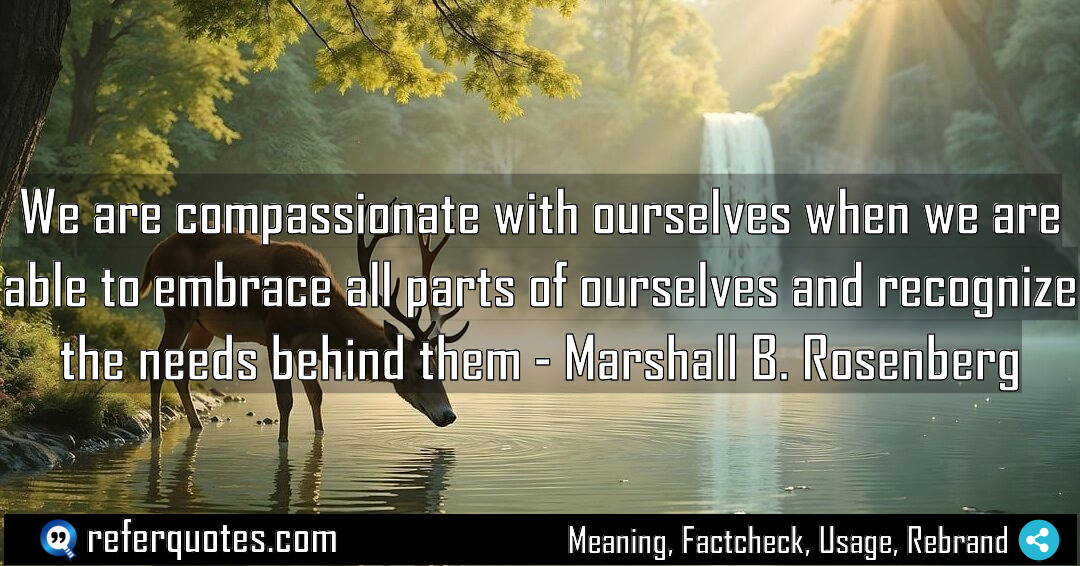
We are compassionate with ourselves when we… stop fighting our own humanity. It’s about embracing every part of who we are, even the messy bits, to find the real needs driving us.
Share Image Quote:
Table of Contents
Meaning
True self-compassion isn’t just about being nice to yourself; it’s a radical act of welcoming all your parts—the angry, the scared, the insecure—and listening to what they’re trying to tell you.
Explanation
Let me break this down from my own experience. For years, I thought self-compassion was about positive affirmations. You know, telling myself I was great in the mirror. But that never really stuck. What Rosenberg is talking about is a complete game-changer. It’s moving from judgment to curiosity. That part of you that feels lazy? Instead of beating yourself up, you get curious. You ask, “What’s the need behind this feeling?” Maybe it’s a need for rest. For meaning. For support. When you embrace the so-called “lazy” part and hear its need for rest, the entire dynamic shifts. You’re no longer at war with yourself. You’re collaborating. And that, my friend, is where real, sustainable change begins.
Quote Summary
Reading Level80
Aesthetic Score90
Origin & Factcheck
This is pure Marshall Rosenberg. It comes straight from his seminal 1999 book, Nonviolent Communication: A Language of Life, which he developed while working as a mediator in the United States. You sometimes see this kind of wisdom misattributed to Buddhist teachers or modern self-help gurus, but the specific framing of connecting feelings to underlying needs is the cornerstone of his NVC model.
Attribution Summary
Where is this quotation located?
| Quotation | We are compassionate with ourselves when we are able to embrace all parts of ourselves and recognize the needs behind them |
| Book Details | Publication Year: 1999; ISBN: 9781892005038; Last edition: 3rd Edition (2015); Number of pages: 264. |
| Where is it? | Chapter 9: Connecting Compassionately with Ourselves, Page 150 (2015 edition) |
Context
In the book, this isn’t just a standalone nice idea. It’s the critical foundation for the entire NVC process. Rosenberg argues that you simply cannot communicate authentically and empathetically with others until you can first do it for yourself. If you’re judging your own anger or fear, you’ll inevitably judge it in others. This quote sits at the heart of that internal work.
Usage Examples
So how do you actually *use* this? Let’s get practical.
Imagine you’re a manager feeling frustrated with a team member. Instead of just reacting, you turn inward. You notice the frustration (that’s the part to embrace). You ask, “What’s the need here?” Maybe it’s a need for collaboration or reliability. Now you can address *that* need with them, not just the frustration.
Or, you’re a parent who just yelled at your kids. The guilt is overwhelming. Embrace the guilty part. What’s its need? Probably for connection and respectful parenting. Acknowledge that need, forgive yourself, and you’ll find a better path forward than just stewing in shame.
For anyone dealing with procrastination: Instead of “I’m so lazy,” you get curious. “What need is my procrastination serving? A need to avoid overwhelm? A need for fun?” Address the *need*, and the procrastination often loses its power.
To whom it appeals?
Share This Quote Image & Motivate
Motivation Score90
Popularity Score88
Shareability Score85
FAQ
Question: Isn’t this just making excuses for bad behavior?
Answer: That’s the most common pushback, and it’s a great question. The key is that embracing the part doesn’t mean endorsing the action. You embrace the *anger*, you don’t embrace *yelling*. By understanding the need behind the anger (e.g., to be heard), you can find a *more effective* strategy to meet that need than yelling ever could.
Question: How is this different from just accepting myself?
Answer: Acceptance can be passive. This is active. It’s a diagnostic process. It’s not just saying “It’s okay I’m angry,” it’s asking “Why am I angry? What is my heart truly asking for?” It’s acceptance plus actionable insight.
Question: What if I can’t figure out the need behind a feeling?
Answer: Totally normal, especially at first. Rosenberg has a whole list of universal human needs (autonomy, connection, peace, play, etc.). It’s like a checklist. When you feel a difficult emotion, scan the list. Does one of them resonate? It gets faster with practice.
Similar Quotes
When we give ourselves empathy, we allow our true self to emerge. It’s about creating a safe space internally, so your authentic self can finally show up without fear or…
The more we practice Nonviolent Communication reveals a profound truth. It’s not just a technique, it’s a path to our natural state of compassion. This shifts the entire goal from…
True compassion means not only feeling another’s pain… it’s a call to action. It’s the difference between seeing a problem and actually rolling up your sleeves to fix it. Goleman…
Our ability to offer empathy can allow us to stay vulnerable… it sounds simple, but this is the secret sauce to defusing conflict and creating real connection. It’s about disarming…
When we help ourselves, we find moments of happiness… but it’s helping others that unlocks a deeper, lasting sense of fulfillment. It’s the difference between a quick hit and a…
